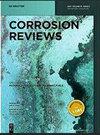铬钝化与铈钝化Zn/NdFeB磁体耐蚀性能的比较
IF 3.2
4区 材料科学
Q3 ELECTROCHEMISTRY
引用次数: 0
摘要
摘要由于铬离子对人体的严重危害,钕铁硼磁体表面锌涂层的无铬钝化成为研究热点。分别对电镀Zn/NdFeB进行了铬基和铈基钝化工艺。用扫描电镜、x射线衍射和x射线光电子能谱对两种钝化膜的形貌、元素组成和相结构进行了表征。通过中性盐雾试验、加速老化试验和电化学测试对两种钝化试样的耐蚀性进行了比较。在锌/钕铁硼表面形成完整、光滑的钝化膜,填充了锌涂层中的空隙和孔隙。与未钝化的Zn/NdFeB相比,Zn(Ce)/NdFeB和Zn(Cr)/NdFeB具有优异的耐蚀性。相比之下,Zn(Ce)/NdFeB具有优异的防腐性能,其红锈出现时间从288 h增加到432 h,仍低于Zn(Cr)/NdFeB的528 h,因此,应进一步研究铈钝化技术在腐蚀过程中的自修复效果,以达到取代铬钝化技术的目的。本文章由计算机程序翻译,如有差异,请以英文原文为准。
Comparison of the corrosion resistances of chromium-passivated and cerium-passivated Zn/NdFeB magnets
Abstract Chromium-free passivation of Zn coating on NdFeB magnets becomes a research hotspot due to the serious harm of chromium ions to the human body. Chromium-based and cerium-based passivation technologies are conducted on electroplating Zn/NdFeB respectively. Morphologies, elemental compositions and phase structures of the two passivated coatings are characterized by scanning electron microscopy, X-ray diffraction and X-ray photoelectron spectroscopy, respectively. The corrosion resistances of the two passivated specimens are compared by neutral salt spray test, accelerated aging test and electrochemical measurements. A complete and smooth passivation film can be obtained on the surface of Zn/NdFeB, filling the gaps and pores in Zn coating. Compared with un-passivated Zn/NdFeB, Zn(Ce)/NdFeB and Zn(Cr)/NdFeB possess excellent corrosion resistance. In comparison, Zn(Ce)/NdFeB possesses excellent anti-corrosion performance, increasing the red-rust appearing time from 288 to 432 h, which is still lower than that of Zn(Cr)/NdFeB (528 h). Therefore, the self-repair effect of cerium passivation technology during the corrosion process should be further studied to achieve the purpose of replacing chromium passivation technology.
求助全文
通过发布文献求助,成功后即可免费获取论文全文。
去求助
来源期刊

Corrosion Reviews
工程技术-材料科学:膜
CiteScore
5.20
自引率
3.10%
发文量
44
审稿时长
4.5 months
期刊介绍:
Corrosion Reviews is an international bimonthly journal devoted to critical reviews and, to a lesser extent, outstanding original articles that are key to advancing the understanding and application of corrosion science and engineering in the service of society. Papers may be of a theoretical, experimental or practical nature, provided that they make a significant contribution to knowledge in the field.
 求助内容:
求助内容: 应助结果提醒方式:
应助结果提醒方式:


